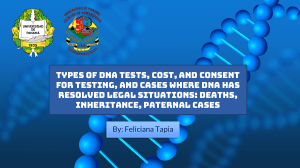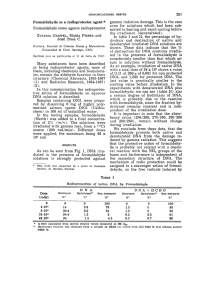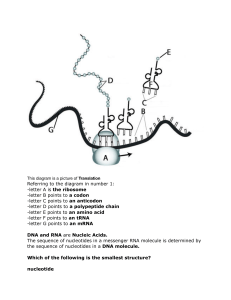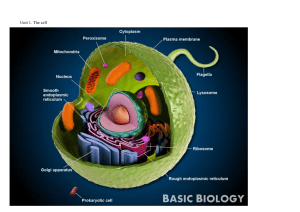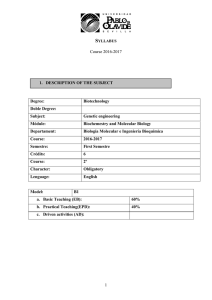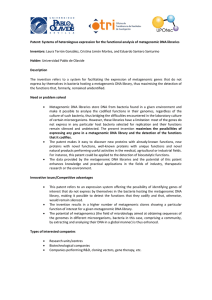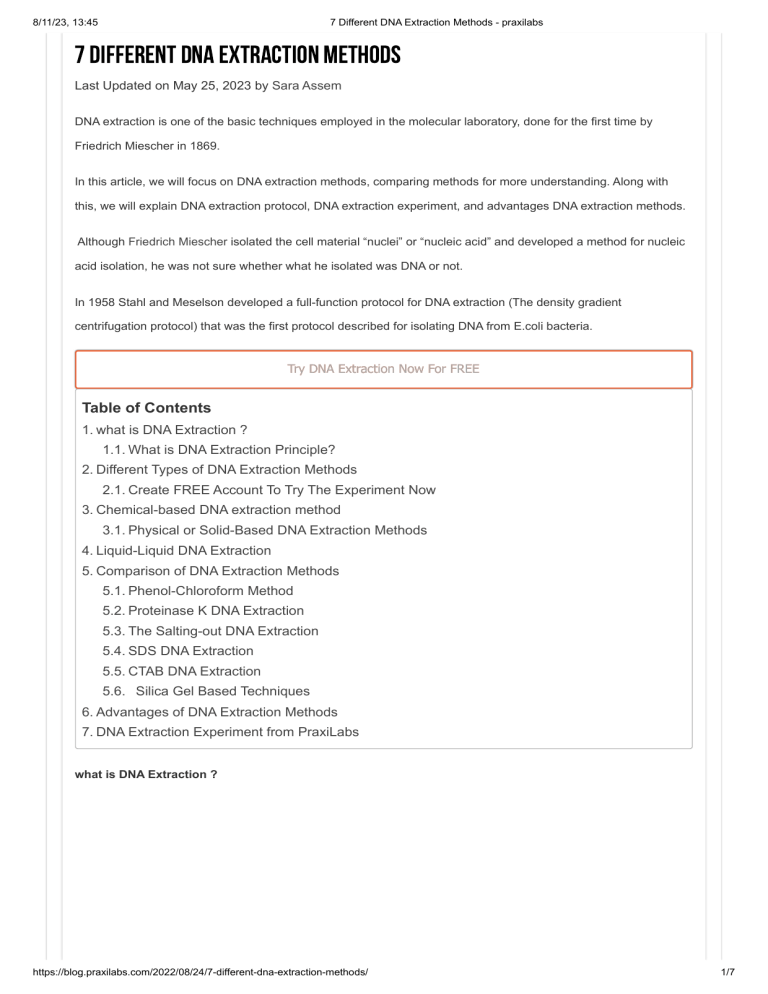
8/11/23, 13:45 7 Different DNA Extraction Methods - praxilabs 7 Different DNA Extraction Methods Last Updated on May 25, 2023 by Sara Assem DNA extraction is one of the basic techniques employed in the molecular laboratory, done for the first time by Friedrich Miescher in 1869. In this article, we will focus on DNA extraction methods, comparing methods for more understanding. Along with this, we will explain DNA extraction protocol, DNA extraction experiment, and advantages DNA extraction methods. Although Friedrich Miescher isolated the cell material “nuclei” or “nucleic acid” and developed a method for nucleic acid isolation, he was not sure whether what he isolated was DNA or not. In 1958 Stahl and Meselson developed a full-function protocol for DNA extraction (The density gradient centrifugation protocol) that was the first protocol described for isolating DNA from E.coli bacteria. Try DNA Extraction Now For FREE Table of Contents 1. what is DNA Extraction ? 1.1. What is DNA Extraction Principle? 2. Different Types of DNA Extraction Methods 2.1. Create FREE Account To Try The Experiment Now 3. Chemical-based DNA extraction method 3.1. Physical or Solid-Based DNA Extraction Methods 4. Liquid-Liquid DNA Extraction 5. Comparison of DNA Extraction Methods 5.1. Phenol-Chloroform Method 5.2. Proteinase K DNA Extraction 5.3. The Salting-out DNA Extraction 5.4. SDS DNA Extraction 5.5. CTAB DNA Extraction 5.6. Silica Gel Based Techniques 6. Advantages of DNA Extraction Methods 7. DNA Extraction Experiment from PraxiLabs what is DNA Extraction ? https://blog.praxilabs.com/2022/08/24/7-different-dna-extraction-methods/ 1/7 8/11/23, 13:45 7 Different DNA Extraction Methods - praxilabs DNA extraction is a process that used to purify DNA by using chemical or physical methods from a biological sample separating DNA from protein, cell membranes, and other cellular components. DNA extraction protocol involves lysis of membranes for DNA extraction, then separating DNA from impurities like proteins, and other substances. What is DNA Extraction Principle? DNA extraction involves lysis of cellular and nuclear membranes in order to extract DNA from within. This is followed by DNA separation from impurities, proteins, and other substances. General Stages of DNA Extraction are: Cell dissolution: lysis of cell and the nucleus to extract DNA into the buffer. Precipitation: removing the impurities and proteins from the sample. Purification: This final stage is done to get a completely pure DNA sample ready to be used. Note: the main steps remain similar among all DNA extraction methods. For more information about DNA extraction, visit our article “DNA Extraction Virtual Lab Experiment from PraxiLabs” Different Types of DNA Extraction Methods https://blog.praxilabs.com/2022/08/24/7-different-dna-extraction-methods/ 2/7 8/11/23, 13:45 7 Different DNA Extraction Methods - praxilabs Depending upon the sample type, every DNA extraction method varies, for example, the DNA extraction method for plant DNA is different from that of the blood. Likewise, the bacterial DNA isolation method is different from other types. So, varieties of DNA extraction methods are needed for different samples. DNA extraction methods are broadly categorized into: 1. Chemical-based (or solution- based) DNA extraction methods. 2. Solid-phase DNA extraction methods (Physical method). Create FREE Account To Try The Experiment Now Chemical-based DNA extraction method The Chemical or solution-based method uses many organic and inorganic solutions. Chemicals like phenol, chloroform, CTAB Triton X100, SDS, isoamyl alcohol, Tris and EDTA are used in the chemical -based DNA extraction method. The solution-based or chemical-based DNA extraction method is subdivided into: Organic solvent-based DNA extraction This method depends on the use of organic substances such as phenol and chloroform. Example: Phenol-chloroform and isoamyl alcohol Inorganic solvent-based DNA extraction It depends on the inorganic solvents. Example: Proteinase K DNA extraction Salting out method SDS DNA extraction CTAB DNA extraction Silica-gel-based techniques Physical or Solid-Based DNA Extraction Methods https://blog.praxilabs.com/2022/08/24/7-different-dna-extraction-methods/ 3/7 8/11/23, 13:45 7 Different DNA Extraction Methods - praxilabs Paper DNA extraction Magnetic bead DNA extraction Liquid-Liquid DNA Extraction Liquid-liquid extraction is one of the commonest methods for nucleic acid extraction. In this method the solutions prepared by various chemical compositions are used for extraction and it mainly relies on lysis buffer preparation. Lysis buffer is prepared in one or two solutions as it uses many chemicals. Common chemicals that used for liquidliquid DNA extraction are Phenol, chloroform, isoamyl alcohol, CTAB, SDS, Tris, EDTA, MgCl2, and other detergents. These methods commonly require centrifugation for separation. Examples of liquid-liquid DNA extraction methods: Phenol, chloroform and isoamyl alcohol DNA extraction, SDS DNA extraction and CTAB DNA extraction. Comparison of DNA Extraction Methods Phenol-Chloroform Method In this method we can separate the DNA based on the solubility of DNA molecules in immiscible solutions, and that is called the liquid-liquid DNA extraction methods (the phenol chloroform DNA extraction method is one of these methods). Although this method is considered one of the best methods, it is less recommended because of phenol and chloroform harmful. The quantity and quality of DNA obtained by method are very good. This method is known as a phenol-chloroform and isoamyl alcohol or PCI method of DNA extraction. The major chemicals of PCI DNA extraction methods are Phenol, chloroform and lysis buffer (contains EDTA, Tris, NaCl, MgCl2, SDS, and other salts). The organic component of the technique- phenol and chloroform denature the protein portion of cells and lysis buffer components help in the cell membrane and nuclear lysis. The lysis buffer contains salts like EDTA, NaCl, Tris and SDS. In principle, the phenol digests proteins, isoamyl alcohol separates nucleic acid and chloroform reduces the foaming between interphase. https://blog.praxilabs.com/2022/08/24/7-different-dna-extraction-methods/ 4/7 8/11/23, 13:45 7 Different DNA Extraction Methods - praxilabs The main advantage of the PCI is that it can isolate DNA from nearly all tissue types (It works for animal, plant and bacterial cells) and it can isolate RNA when used with guanidine thiocyanate. Unfortionatly, this method is it is unsafe because Phenol is volatile and can cause burns. the chloroform can faint us. So, it requires training and to prepare and handle chemicals. PraxiLabs provides the DNA extraction experiment at our biology virtual lab that based on the phenol chloroform extraction method … Subscribe and try it now Proteinase K DNA Extraction The proteinase K-based method is one of inorganic solution-based technique for DNA extraction. The proteinase K DNA extraction method provides high quantity of DNA but thee disadvantage of this method is that takes long time. Also, in case of not maintained well in a cold chain, the enzyme proteinase K cannot be utilized for a longer period of time. Another major problem is that The stability of the enzyme is low. The Salting-out DNA Extraction extraction method is a simple and non-toxic technique that isolates a high-quality DNA from the whole blood. In the standard salting-out method, proteins K and RNase are added to them after the lysis of cells. Saturated NaCl was needed for the proteins to precipitate out of the solution. The cell samples are centrifuged and then, DNA is separated by washing it with detergent like ethanol. The salting-out DNA extraction method is safer than the phenol-chloroform method. It depends on the usage of salts such as potassium acetate, sodium chloride, and ammonium acetate that help in DNA extraction. This method gives excellent results in combination with proteinase K and enough yield can be obtained but the quality (purity) obtained might not be good. https://blog.praxilabs.com/2022/08/24/7-different-dna-extraction-methods/ 5/7 8/11/23, 13:45 7 Different DNA Extraction Methods - praxilabs SDS DNA Extraction SDS or sodium dodecyl sulfate is an anionic detergent that digests nuclear and cell membrane proteins. SDS gives a negative charge to each protein as a function of their size. Because all of proteins have the same shape in the gel separation they are separated only for their size. So, SDS can be used to aid in lysing cell during DNA extraction. CTAB DNA Extraction CTAB or Cetyl Trimethyl Ammonium Bromide is a chemical often used in DNA extraction. This method is a specially prepared liquid-liquid and solution-based extraction method for plant DNA extraction. The CTAB buffer removes polysaccharides and polyphenols effectively and gives excellent yield for plant DNA. This method required extensive chemical preparation and additional techniques like tissue homogenization and the use of liquid nitrogen. It also takes a long time. Silica Gel Based Techniques In the spin-column DNA extraction technique, a silica gel as a solid phase is immobilized in a tube. A specially prepared lysis buffer is used to digest the sample and allows it to separate on a solid phase. the sample is Centrifuged first to remove all the debris by protecting the DNA and changing the pH of the solution(to elutes DNA in the last step). these techniques are now commercially available. Spin column is the most advanced, effective, rapid and accurate separation technique. It is, however, a chemical method of DNA extraction but works on the principle of solid-phase separation. The main advantage of this technique is that can isolate DNA from any biological sample and tissue. However, it is difficult to isolate DNA from plants even using the spin-column technique, Different columns are now available depending upon the sample type. But this technique is Cost, lacks optimizations and the yield remains comparatively low but good. Advantages of DNA Extraction Methods DNA extraction is vital to biology, especially biotechnology. It is the first step of different applications like fundamental research, disease diagnosis and therapeutic decision. https://blog.praxilabs.com/2022/08/24/7-different-dna-extraction-methods/ 6/7 8/11/23, 13:45 7 Different DNA Extraction Methods - praxilabs One of the main advantages of DNA extraction methods is that they are very importance to define the unique characteristics of DNA like the shape, the size and function. DNA extraction is used in medical conditions investigation such as Down syndrome and cystic fibrosis. It is also helpful in case of identification if a person is a carrier of the disease or not. So, by DNA sequence in relation to diseases, It helped in finding out the molecular basis and cure for various diseases. In criminal investigations, DNA extraction from samples (e.g., hair – skin – blood) is used to determine if a person is a suspect or not and also it can prove whether a person was in the vicinity of the crime scene. It also used in Paternity Tests. It can be useful in genetic engineering. For animals, DNA extraction is helpful for transforming and cloning animal’s DNA. For plants, DNA can be useful in identifying and extracting a specific gene in order to replicate in generations of plants. DNA study also helped in creating many vaccines (e.g., Hepatitis B vaccine), hormones (e.g., growth hormones and insulin), and enzymes. DNA Extraction Experiment from PraxiLabs PraxiLabs provides DNA extraction lab that used to extract cellular DNA using phenol/chloroform method. The following video shows the steps of DNA extraction in the virtual lab: By the end of the experiment, students are able to understand one of the DNA extraction methods as well as efficiently deal with the protocol involved in DNA extraction in a safe environment with the ability to repeat the experiment an unlimited number of times at any time and from anywhere. Try the virtual lab of the DNA extraction simulation now https://blog.praxilabs.com/2022/08/24/7-different-dna-extraction-methods/ 7/7

